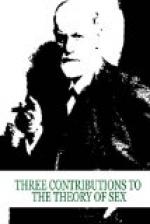We can also venture an opinion about the mechanisms of such sublimation. The sexual feelings of these infantile years on the one hand could not be utilizable, since the procreating functions are postponed,—this is the chief character of the latency period; on the other hand, they would in themselves be perverse, as they would emanate from erogenous zones and would be born of impulses which in the individual’s course of development could only evoke a feeling of displeasure. They therefore awaken contrary forces (feelings of reaction), which in order to suppress such displeasure, build up the above mentioned psychic dams: loathing, shame, and morality.[8]
The Interruptions of the Latency Period.—Without deluding ourselves as to the hypothetical nature and deficient clearness of our understanding regarding the infantile period of latency and delay, we will return to reality and state that such a utilization of the infantile sexuality represents an ideal bringing up from which the development of the individual usually deviates in some measure and often very considerably. A portion of the sexual manifestation which has withdrawn from sublimation occasionally breaks through, or a sexual activity remains throughout the whole duration of the latency period until the reinforced breaking through of the sexual impulse in puberty. In so far as they have paid any attention to infantile sexuality the educators behave as if they shared our views concerning the formation of the moral forces of defence at the cost of sexuality, and as if they knew that sexual activity makes the child uneducable; for the educators consider all sexual manifestations of the child as an “evil” in the face of which little can be accomplished. We have, however, every reason for directing our attention to those phenomena so much feared by the educators, for we expect to find in them the solution of the primitive formation of the sexual impulse.
THE MANIFESTATIONS OF THE INFANTILE SEXUALITY
For reasons which we shall discuss later we will take as a model of the infantile sexual manifestations thumbsucking (pleasure-sucking), to which the Hungarian pediatrist, Lindner, has devoted an excellent essay.[9]
Thumbsucking.—Thumbsucking, which manifests itself in the nursing baby and which may be continued till maturity or throughout life, consists in a rhythmic repetition of sucking contact with the mouth (the lips), wherein the purpose of taking nourishment is excluded. A part of the lip itself, the tongue, which is another preferable skin region within reach, and even the big toe—may be taken as objects for sucking. Simultaneously, there is also a desire to grasp things, which manifests itself in a rhythmical pulling of the ear lobe and which may cause the child to grasp a part of another person (generally the ear) for the same purpose. The pleasure-sucking is connected with an entire exhaustion of attention and leads to sleep or even to a motor reaction in the form of an orgasm.[10] Pleasure-sucking is often combined with a rubbing contact with certain sensitive parts of the body, such as the breast and external genitals. It is by this road that many children go from thumb-sucking to masturbation.




